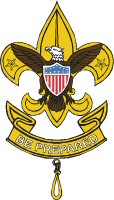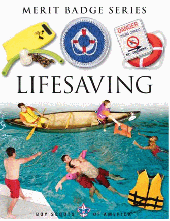User Tools
This is an old revision of the document!
Boy Scouts of America
On 23 February 2009, the U.S. Coast Guard Auxiliary signed a Memorandum of Agreement to partner with the Boy Scouts of America (BSA). The Auxiliary's Recreational Boating Safety Outreach Directorate is coordinating the implementation to make this a meaningful agreement for the two organizations.
Boy Scouting is a membership level of the Boy Scouts of America (BSA) for boys and young men. It provides effective youth training in character, citizenship, and mental and personal fitness. Boy Scouts are expected to develop personal religious values, learn the principles of American heritage and government, and acquire skills to become successful adults.
To achieve these, Boy Scouting applies eight methods of Scouting: ideals, the patrol method, participation in outdoor programs, advancement, adult association, personal growth, leadership development, and the uniform.
Boy Scouting is generally available to boys between the ages of 11 and 17. They are organized in Scout troops, administered by volunteers with support of paid professional staff. Youth and adult members are Scouts, the boys are referred to as Boy Scouts, and the adults as Scouters.
Organization
Local Boy Scout units are “Troops.” Troops work together in a Scout “District”. Two or more districts comprise a Scout “Council”. There are four Scout “Regions” (Northeast, Southern, Central and Western) that include approximately 80 councils each. There are over 300 councils nationally.
Program and activities
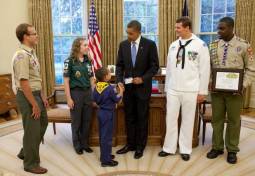 Boy Scouts of America troop program and activities are determined by the senior patrol leader and the patrol leaders council under the oversight of the Scoutmaster. Troops generally hold meetings weekly, although they can be irregular during the summer. Troop meeting activities may vary from training in Scout skills to planning camping trips or playing games.
Boy Scouts of America troop program and activities are determined by the senior patrol leader and the patrol leaders council under the oversight of the Scoutmaster. Troops generally hold meetings weekly, although they can be irregular during the summer. Troop meeting activities may vary from training in Scout skills to planning camping trips or playing games.
Troops may plan outings and activities outside the troop meeting. These may involve camping, backpacking, hiking, canoeing, rafting, climbing, caving, rappelling and other activities. These outings are an important place for Scouts to work on skills and rank advancement, have fun, and engage in productive outdoor activities.
Scout gatherings
Most councils own and operate one or more permanent camps. These camps may host a variety of activities throughout the year. The summer camp program provides a week-long session for troops that includes merit badge advancement and adventure activities. Facilities may include ranges for shooting sports, archery, rifle, and shotgun, and for climbing and rappelling.
It is common for several troops within a district or council to gather at least once a year at a special weekend campout called a camporee. A camporee is a regional event where several units camp and engage in activities, Scoutcraft competitions and learn specialized skills.
The National Scout Jamboree usually occurs every four years, and draws more than 30,000 Scouts from across the country and the world. The last jamboree took place in 2017, and the next will occur in 2019, during the World Scout Jamboree.
Advancement and recognition
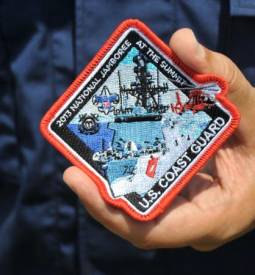 Boy Scouts has seven ranks, grouped into two phases. The first phase of Scout, Tenderfoot, Second Class and First Class is designed to teach the boy Scoutcraft skills, teamwork and self-reliance. Scout is the first rank, awarded when a boy first joins the Scouts, and requires just a rudimentary knowledge of Scouting's ideals.
Boy Scouts has seven ranks, grouped into two phases. The first phase of Scout, Tenderfoot, Second Class and First Class is designed to teach the boy Scoutcraft skills, teamwork and self-reliance. Scout is the first rank, awarded when a boy first joins the Scouts, and requires just a rudimentary knowledge of Scouting's ideals.
Further ranks have progressive requirements in the areas of Scoutcraft, physical fitness, citizenship, personal growth, and Scout Spirit. Scouts with a permanent mental or physical disability may use alternate requirements, based on their abilities and approved by the council.
The second phase of Star, Life and Eagle is designed to develop leadership skills and encourage the Scout to explore potential vocations and avocations through the merit badge program. These ranks require that the boy serve in a position of responsibility and perform community service.
Eagle Scout
The Eagle Scout requires, in addition to merit badges and a position of responsibility, a community service project planned and led entirely by the Eagle Scout candidate. After attaining the rank of Eagle, a Scout may earn Eagle Palms for additional tenure and merit badges.
Although Eagle is the highest rank, for which Scouts should strive, the number of Scouts achieving First Class within one year of joining is still one of the key measures of unit effectiveness. Studies have shown that, if a Scout achieves First Class within a year of joining, he typically stays in Scouting for at least three years. Scouts who do so are more likely to retain Scout values as an adult.
Ranks and other recognitions are presented in a troop awards ceremony called the court of honor. The Eagle Scout rank is usually presented in a separate and special court of honor.
Other awards
Other advancement and recognitions, such as the Mile Swim Award, Crime Prevention Awards, Emergency Preparedness Award and World Conservation Award, are available to Scouts who show proficiency in special areas. Boy Scouts of America's National Court of Honor is responsible for lifesaving and meritorious awards. All Courts of Honor for Eagle Scout are convened as National Courts of Honor also.
Leadership in the troop
 Every troop has two separate leadership structures: one consisting of Scouts and another consisting of adults. The adult leadership manages the logistics of troop activities, administers rank advancement and awards, maintains troop records and finance, and recruits new Scouts and adult leaders. The youth leadership keeps order and coordinates labor at activities. Scouts and adults cooperate to plan agendas for troop meetings, as well as the troop's schedule of outings.
Every troop has two separate leadership structures: one consisting of Scouts and another consisting of adults. The adult leadership manages the logistics of troop activities, administers rank advancement and awards, maintains troop records and finance, and recruits new Scouts and adult leaders. The youth leadership keeps order and coordinates labor at activities. Scouts and adults cooperate to plan agendas for troop meetings, as well as the troop's schedule of outings.
Adult development
The Scoutmaster provides Troop Leadership Training (TLT) at the troop level. Youth leaders are encouraged to attend National Youth Leadership Training (NYLT) at the council level, and a select few may progress to National Advanced Youth Leadership Experience (NAYLE) at the national level. Those interested in staffing these courses may complete the Youth Staff Development Course (YSDC) at the regional level.
New adult leaders are encouraged to attend training for their position. This training provides the essential information they need to provide a safe and successful quality program. Fast Start Training is the introduction for adult leaders new to the Boy Scout program; it is self pace and provided as a video or online. New Leader Essentials is common core training for adult leaders in the and gives an overview of the Scouting.
Youth protection
Youth Protection Training (YPT) covers the BSA policies on child abuse, including types and signs of abuse, how to respond to disclosed abuse and how to report suspected abuse. Units are required to have adults who are YPT certified and responsible for training youth. YPT recertification intervals are determined by the local council policy. At least one person with current YPT certification must be preset on outings.
Initial training
Scoutmasters and assistants should then attend Scoutmaster and Assistant Scoutmaster Specific Training and Introduction to Outdoor Leader Skills for further instruction in Scouting and outdoor skills. The troop committee chairman and members should attend the Troop Committee Challenge for instruction in administering the program. Such training completes Basic Leader Training for these positions.
Supplemental training modules are designed to provide orientation beyond Basic Leader Training. These shorter training sessions are often provided at the Roundtable, a monthly meeting of leaders from the district, at a University of Scouting offered by the local councils, and at National Training Conferences held at the Philmont Training Center and the Florida National High Adventure Sea Base.
At least one leader with current Safe Swim Defense training is required for swimming activities. Boating activities require Safety Afloat and CPR training. Climb On Safely training and CPR certification are required for climbing and rappelling events.
Scout Camps
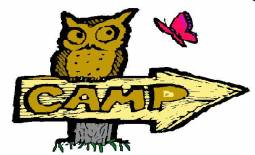 Boy Scouts of America Scout Camps are owned and operated by local councils of the Boy Scouts of America. Although, historically, Scout camps have provided support to the Boy Scout program, many Scout camps also provide day and residential programs for Cub Scouts, and a few have Venturing and/or Sea Scout opportunities.
Boy Scouts of America Scout Camps are owned and operated by local councils of the Boy Scouts of America. Although, historically, Scout camps have provided support to the Boy Scout program, many Scout camps also provide day and residential programs for Cub Scouts, and a few have Venturing and/or Sea Scout opportunities.
Depending on your local area, most Scout camps provide a varied aquatics program, including some or all of the following: swimming, lifesaving, canoeing, rowing and small-boat sailing. A few local Scout camps offer organized sail training programs or week-long cruising experiences. Additionally, the Florida Sea Base offers a varied aquatics-focused program that includes sailing, scuba diving, and out-island adventures in the Florida Keys
The Boy Scouts of America requires that all BSA-owned or operated watercraft receive annual Vessel Safety Checks from the U.S. Coast Guard Auxiliary or the U.S. Power Squadrons. These watercraft are employed in support of Scout camps, as well as the Sea Scout program, and some Boy Scout and Venturing units.
Resources
Awards and insignia
Scout camps
Other resources
 BSASeaScouts3252013 (BSA Communications)
BSASeaScouts3252013 (BSA Communications)
Auxiliary
- Coast Guard offers unique educational experience at National Scout Jamboree (Coast Guard Compass)

